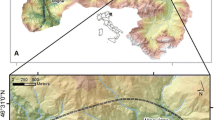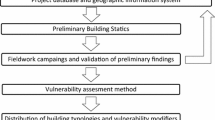Abstract
Alpine hazards such as debris flow, floods, snow avalanches, rock falls, and landslides pose a significant threat to local communities. The assessment of the vulnerability of the built environment to these hazards in the context of risk analysis is a topic that is growing in importance due to global environmental change impacts as well as socio-economic changes. Hence, the vulnerability is essential for the development of efficient risk reduction strategies. In this contribution, a methodology for the development of a vulnerability curve as a function of the intensity of the process and the degree of loss is presented. After some modifications, this methodology can also be used for other types of hazards in the future. The curve can be a valuable tool in the hands of local authorities, emergency and disaster planners since it can assist decision making and cost–benefit analysis of structural protection measures by assessing the potential cost of future events. The developed methodology is applied in two villages (Gand and Ennewasser) located in Martell valley, South Tyrol, Italy. In the case study area, buildings and infrastructure suffered significant damages following a debris flow event in August 1987. The event caused extensive damage and was very well documented. The documented data were used to create a vulnerability curve that shows the degree of loss corresponding to different process intensities. The resulting curve can be later used in order to assess the potential economic loss of future events. Although the validation process demonstrated the reliability of the results, a new damage assessment documentation is being recommended and presented. This documentation might improve the quality of the data and the reliability of the curve. The presented research has been developed in the European FP7 project MOVE (Methods for the Improvement of Vulnerability Assessment in Europe).








Similar content being viewed by others
References
Akbas SO, Blahut J, Sterlacchini S (2009) Critical assessment of existing physical vulnerability estimation approaches for debris flows. In: Malet JP, Remaître A, Bogaard T (eds) Proceedings of landslide processes: from geomorphologic mapping to dynamic modeling, Strasbourg, 6–7 Feb 2009, pp 229–233
Autonome Provinz Bozen (2010) Richtpreisverzeichnis Hochbauarbeiten 2010. Autonome Provinz Bozen, Südtirol
Barbolini M, Cappabianca F, Sailer R (2004) Empirical estimate of vulnerability relations for use in snow avalanche risk assessment. In: Brebbia CA (ed) Risk analysis, vol IV. WIT Press, Southampton, pp 533–542
Birkmann J (2006) Measuring vulnerability to promote disaster resilient societies. Conceptual frameworks and definitions. In: Birkmann J (ed) Measuring vulnerability to natural hazards—towards disaster resilient societies. United Nations University Press, Tokyo, pp 9–54
BUWAL (Bundesamt für Umwelt, Wald und Landschaft) (1999) Risikoanalyse bei gravitativen Naturgefahren: Methode, Umweltmaterialen No 107/1. Naturgefahren, Bern, p 115
Cappabianca F, Barbolini M, Natale L (2008) Snow avalanche risk and mapping: a new method based on a combination of statistical analysis, avalanche dynamics simulation and empirically based vulnerability relations integrated in a GIS platform. Cold Reg Sci Technol 54:193–205
Corominas J, Copons R, Moya J, Vilaplana JM, Altimir J, Amigó J (2005) Quantitative assessment of the residual risk in a rock fall protected area. Landslides 2:343–357
Douglas J (2007) Physical vulnerability modeling in natural hazard risk assessment. Nat Hazards Earth Syst Sci 7:283–288
Egli T (2005) Wegleitung Objektschutz gegen gravitative Naturgefahren. Vereinigung Kantonaler Feuerversicherungen, Bern
FEMA (2010) Worksheet Building, publication number: 086-0-7. http://www.fema.gov/library/resultFemaNumber.do;jsessionid=F4E46A0F931097E6228F19B154B7BB17.Worker2Library. Accessed 25 Jan 2012
Fuchs S (2009) Susceptibility versus resilience to mountain hazards in Austria—paradigms of vulnerability revisited. Nat Hazards Earth Syst Sci 9:337–352
Fuchs S, McAlpin MC (2005) The net benefit of public expenditures on avalanche defence structures in the municipality of Davos, Switzerland. Nat Hazards Earth Syst Sci 5:319–330
Fuchs S, Keiler M, Zischg A, Bründl M (2005) The long-term development of avalanche risk in settlements considering the temporal variability of damage potential. Nat Hazards Earth Syst Sci 5(6):893–901
Fuchs S, Heiss K, Hübl J (2007) Towards an empirical vulnerability function for use in debris flow risk assessment. Nat Hazards Earth Syst Sci 7:495–506
Ganderton PT (2005) “Benefit-Cost Analysis” of disaster mitigation: application as a policy and decision making tool. Mitig Adapt Strat Glob Change 10:445–465
Gemeinde Martell (2012) Zahlen und Fakten: Das Martelltal. Available on line: http://www.comune.martello.bz.it. Accessed 10 Feb 2012
Holub M, Fuchs S (2009) Mitigating mountain hazards in Austria—legislation, risk transfer, and awareness building. Nat Hazard Earth Syst Sci 9:523–537
Hufschmidt G, Glade T (2010) Vulnerability analysis in geomorphic risk assessment. In: Alcántara-Ayala I, Goudie AS (eds) Geomorphological hazards and disaster prevention. Cambridge University Press, New York, pp 233–243
Hufschmidt G, Crozier M, Glade T (2005) Evolution of natural risk: research framework and perspectives. Nat Hazards Earth Syst Sci 5:375–387
Hufschmidt G (2011) A comparative analysis of several vulnerability concepts. Nat Hazards 58(2):621–643
IPCC (2007) Summary for policymakers. In: Solomon S, Qin D, Manning M, Chen Z, Marquis M, Averyt KB, Tignor M, Miller HL (eds) Climate change 2007: the physical science basis. Contribution of Working Group I to the 4th Assessment Report of the Intergovernmental Panel on Climate Change. Cambridge University Press, Cambridge
IPCC Working Group I (2007) Contribution of Working group I to the 4th Assessment Report of the Intergovernmental Panel on Climate Change 2007. Cambridge University Press, Cambridge, p 996
Iverson MR (1997) The physics of debris flows. Rev Geophys 35(3):245–296
Kappes M, Papathoma-Köhle M, Keiler M (2012) Assessing physical vulnerability for multi-hazards using an indicator-based methodology. Appl Geogr 32(2):577–590
Kaswalder C (2009) Schätzungsstudie zur Berechnung des Schadenspotentials bei Hochwasserereignissen durch die Rienz im Abschnitt Bruneck-St. Lorenzen. Autonome Provinz Bozen, Südtirol
Keiler M (2004) Development of the damage potential resulting from avalanche risk in the periode 1950–2000, case study Galtür. Nat Hazard Earth Syst Sci 4:249–256
Keiler M, Zischg A, Fuchs S, Hama M, Stötter J (2005) Avalanche related dam-age potential—changes of persons and mobile values since the mid-twentieth century, case study Galtür. Nat Hazard Earth Syst Sci 5(1):49–58
Keiler M, Sailer R, Jörg P, Weber C, Fuchs S, Zischg A, Sauermoser S (2006a) Avalanche risk assessment—a multi-temporal approach, results from Galtür, Austria. Nat Hazard Earth Syst Sci 6(4):637–651
Keiler M, Zischg A, Fuchs S (2006b) Methoden zur GIS-basierten Erhebung des Schadenpotenzials für naturgefahreninduzierte Risiken. In: Strobl J, Roth C (eds) GIS und Sicherheitsmanagement. Wichmann, Heidelberg, pp 118–128
Keiler M, Knight J, Harrison S (2010) Climate change and implications for natural hazards in the Eastern European Alps. Philos Trans R Soc A 368:2461–2479
Keylock CJ, Barbolini M (2001) Snow avalanche impact pressure-vulnerability relations for use in risk assessment. Can Geotech J 38:227–238
Mavrouli O, Corominas J (2008) Structural response and vulnerability assessment of buildings in front of the rock fall impact. Geophys Res Abstr 10
Papathoma Köhle M, Kappes M, Keiler M, Glade T (2011) Physical vulnerability assessment for alpine hazards: state of the art and future needs. Nat Hazards 58(2):645–680
Pfitscher A (1996) Wasserkatastrophen im Martelltal. Athesia, Bozen
Quan Luna B, Blahut J, Van Westen CJ, Sterlacchini S, Van Asch TWJ, Akbas SO (2011) The application of numerical debris flow modelling for the generation of physical vulnerability curves. Nat Hazards Earth Syst Sci 11:2047–2060
Regensburger S (2006) Das Martelltal- “Schianbliamtol” das Tal zwischen Gletscher und Erdbeeren. Diplomarbeit (Master thesis), Freie Universität Bozen, p 74
Röhrs M, Glade T (2010) Südtirol. In: Bell R, Mayer J, Pohl J, Greiving S, Glade T (eds) Integrative Frühwarnsysteme für Gravitative Massenbewegungen (ILEWS), pp 39–45
Romang H (2004) Wirksamkeit und Kosten von Wildbach-Schutzmassnahmen. Verlag des Geographischen Instituts der Universität Bern, Bern, p 212
Sterlacchini S, Frigerio S, Giacomelli P, Brambilla M (2007) Landslide risk analysis: a multi-disciplinary methodological approach. Nat Hazards Earth Syst Sci 7:657–675
Stoll C (2004) Flussraum Agenda Alpenraum: Schätzung des Schadenspotentials bei Hochwasserereignissen durch die Ahr bei Uttenheim und St. Georgen und durch die Rienz im Bereich Bruneck bis St. Lorenzen. Autonome Provinz Bozen—Südtirol, Abteilung 30. Wasserschutzbauten, Bruneck, p. 44
Thywissen K (2006) Components of risk. A comparative glossary. Published as SOURCE No. 4—2006 of the Institute of Environment and Human Security of the United Nations University. Available at: http://www.ehs.unu.edu/file/get/4042
Totschnig R, Sedlacek W, Fuchs S (2011) A quantitative vulnerability function for fluvial sediment transport. Nat Hazards 58:681–703
Tsao T-C, Hsu W-K, Cheng C-T, Lo W-C, Chen C-Y, Chang Y-L, Ju J-P (2010) A preliminary study of debris flow risk estimation and management in Taiwan. In: Chen S-C (ed) International symposium Interpraevent in the Pacific Rim—Taipei, 26–30 Apr. Internationale Forschungsgesellschaft Interpraevent, Klagenfurt, pp 930–939
UNDRO (1984) Disaster prevention and mitigation-a compendium of current knowledge. Preparedness aspects, vol 11, New York
UNIQA (2012) Schadenmeldungsformular. Available on line: http://www.uniqa.at/uniqaat/cms/mediacms/media/files/at/485_HHV_Internet.pdf. Accessed 25 Jan 2012
Vinchon C et al. (2011) Assessing vulnerability to natural hazards in Europe: from principles to practice—a manual on concept, methodology and tools. Report of the MOVE-Project D4.2. http://www.move-fp7.eu/documents/MOVE_Manual.pdf
Wisner B, Blaikie P, Cannon T, Davis I (2004) At risk: Natural hazards, people’s vulnerability, and disasters, 2nd edn. Routledge, London
Zimmermann H-J (1993) Fuzzy Technologien: Prinzipien, Werkzeuge, Potentiale. VDI-Verlag, Düsseldorf
Acknowledgments
The research presented in this article was supported by the EU project MOVE (Methods for the Improvement of Vulnerability Assessment in Europe) (http://www.move-fp7.eu, contract number 211590). The authors would also like to thank the Local Authorities of Bolzano and the Municipality of Martell in South Tyrol for the provision of data as well as feedback on the developed methodology during stakeholder meetings. Furthermore, the authors would like to thank Sven Fuchs for the discussions and his contribution at the earlier stages of this study. Last but not least, the authors would like to thank Jan Blahut and an anonymous reviewer for their comments on an earlier draft of this article.
Author information
Authors and Affiliations
Corresponding author
Rights and permissions
About this article
Cite this article
Papathoma-Köhle, M., Keiler, M., Totschnig, R. et al. Improvement of vulnerability curves using data from extreme events: debris flow event in South Tyrol. Nat Hazards 64, 2083–2105 (2012). https://doi.org/10.1007/s11069-012-0105-9
Received:
Accepted:
Published:
Issue Date:
DOI: https://doi.org/10.1007/s11069-012-0105-9




